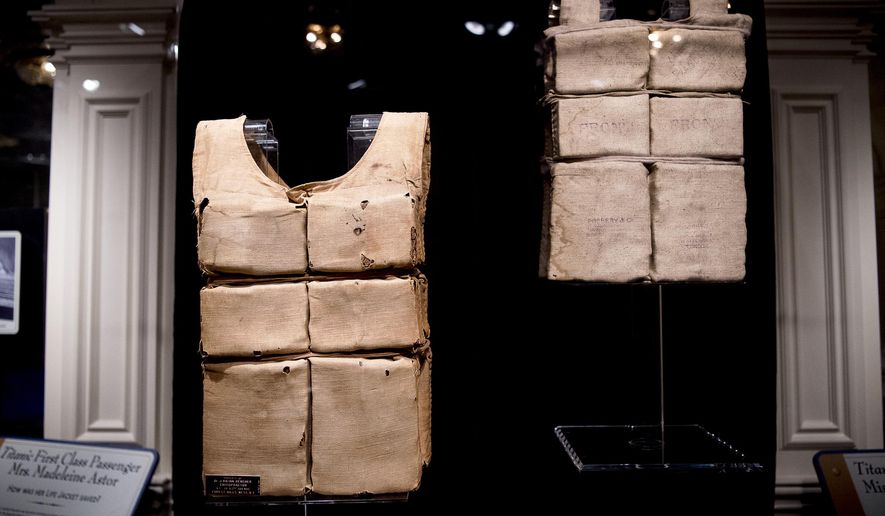PIGEON FORGE, Tenn. (AP) - Laura Mabel Francatelli survived the sinking of the Titanic wearing a life jacket she cherished for the rest of her long life.
Now, for the first time in 107 years, Francatelli’s jacket is on public display. It’s one of six on exhibit through December at the Titanic Museum Attraction in Pigeon Forge.
The six life jackets - two linked to surviving passengers and four others with sadder, less certain pasts - are half of the 12 known to still exist from the Titanic.
The ocean liner sank on its April 15, 1912, maiden voyage, hours after striking an iceberg. A total of 1,503 passengers and crew members died. With too few lifeboats, passengers and crew left behind couldn’t survive the ocean’s below-freezing temperatures.
“It’s very poignant,” Paul Burns, the museum curator, told USA TODAY Network - Tennessee. “This was a tragedy for the survivors and the victims.”
Francatelli’s life jacket was unveiled Tuesday in a ceremony at the museum. Musicians performed “Nearer My God to Thee” - the last song Titanic musicians played - to begin the event.
The jacket, still in excellent condition, is one of only two linked to Titanic surviving passengers. The other, worn by the pregnant socialite Madeleine Astor, is also in the exhibit and has been shown previously at the museum.
Francatelli was sailing on the Titanic as secretary to wealthy fashion designer Lady Duff-Gordon. The two women and Duff-Gordon’s husband, Sir Cosmo Duff-Gordon, were three of 12 people in Titanic’s lifeboat number one.
After they were rescued by the passenger ship Carpathia, Francatelli asked the other people who’d been in the lifeboat to sign her jacket. Some eight to nine signatures, many faded, remain visible on the jacket’s front and back.
“We believe she just wanted to remember who was in the boat with her and survived,” Burns says.
Francatelli later married and lived in New York. She had no children; her jacket passed to a nephew. Eventually its current owner bought the jacket for $118,643 at a 2007 Christie’s auction.
The exhibit is the largest display of the 12 jackets known to exist from the Titanic’s original 3,000. The exhibit is at the 30,000-square-foot museum at 2134 Parkway in Pigeon Forge through December.
The Titanic is infamous for not having enough lifeboats and for several boats leaving the sinking ship with fewer people than they could hold. But the ocean liner carried enough life jackets for its 2,208 passengers and crew. Historians say most everyone wore a jacket.
It took museum staff two years to find the rudimentary jackets made of canvas-covered cork. Some belong to private collectors and haven’t been previously displayed.
Five of the six known jackets not in the exhibit belong to other museums. A sixth was sold at a 2008 Christie’s auction to an unknown buyer.
The exhibit came to Pigeon Forge from the Titanic’s sister museum in Branson, Missouri.
As the Titanic began to sink, John Jacob Astor told his young, pregnant wife Madeleine Astor to put on her life jacket and not take it off.
He would die in the tragedy. She would survive, rescued with others by the Carpathia.
Crew member Gottlieb Rencher helped the weeping pregnant Astor onboard and took her to the ship’s hospital to rest. There, she removed the jacket and left it.
Rencher, who was the Carpathia’s senior assistant to its doctor, kept the jacket. He later became a New York chiropractor and hang the garment in his office for years. His descendants later donated it to the Titanic Historical Society.
On Tuesday, distant Astor cousin Vincent Astor of Memphis saw his relative’s life jacket for the first time. The Memphis resident stood quietly and placed his right hand on the case for a few minutes.
“It makes everything suddenly very real,” Astor said.
But not all these jackets were life savers. The other four on exhibit were likely cut from from bodies recovered from the frigid north Atlantic Ocean.
These jackets, often stained and with straps cut, came from ships sent to retrieve bodies from the ocean after the Titanic sank. No records exist of who may have worn these jackets. But it’s likely no wearer survived.
Two were tracked directly to men who worked on the rescue ship Mackay-Bennett. Workers who retrieved the bodies would have cut the wet, heavy life jackets from the dead, Burns says.
A cable ship contracted by Titanic owner White Star Line, the Mackay-Bennett recovered 306 bodies. But not every corpse could be identified; some were buried at sea.
Seeing the half-dozen jackets, in different conditions and histories, “helps us humanize this,” Burns says.
“To think that between the great vessel that you are on and the elements of nature, this very frigid water, that the only thing between your life and all these elements is this very, very rudimentary designed life jacket,” he says.
“This was people’s security - ’Put on your life jacket and you are going to be OK.’ “
The museum, which opened in 2010, is built as a half-scale reconstruction of the Titanic’s forward half. Inside it includes changing exhibits, some 400 artifacts and re-creations of the ship’s grand staircase and several staterooms.
Each admission ticket is designed as a boarding pass with the name of a person who sailed on the ocean liner. At the end of a tour, a visitor discovers if the person whose name is on the pass survived.
The museum opens daily at 9 a.m.; ticket reservations are at titanicpigeonforge.com or 800-381-7670.
___
Information from: Knoxville News Sentinel, http://www.knoxnews.com




Please read our comment policy before commenting.